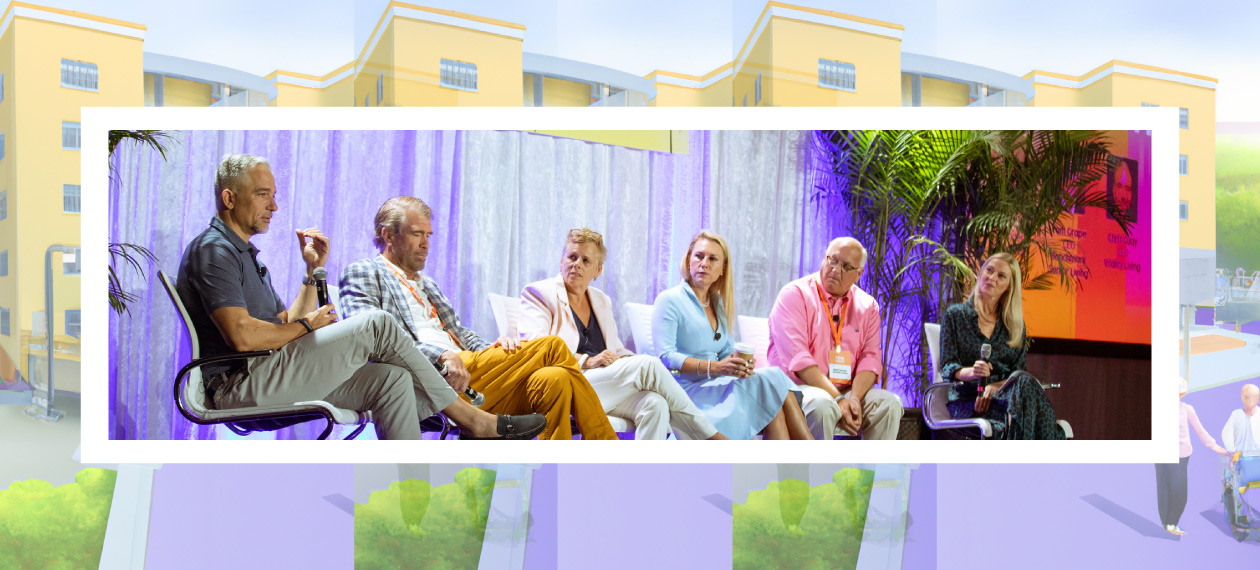The last three years have been transformative for the senior living industry, which rose admirably to face an endless cascade of pressures on virtually every front. Still, that transformation is certain to pale in comparison to the next ten years. A rapidly aging population, the evolving workforce, mergers and acquisitions, new healthcare technologies and delivery models: all of these and more will define the next decade of senior living.
How will these intersecting forces reshape the industry? What should operators do to prepare for them, and where should they devote their already overstretched budgets? These questions formed the heart of a fast-moving discussion at SLIF Fall in Nassau, Bahamas. Moderated by Delight by Design founder Sarah Thomas, the conversation included Tom Grape, CEO of Benchmark Senior Living; Chris Guay, CEO of Vitality Living; Sevy Petras, CEO of Priority Life Care; Scott Stewart, CEO of Capitol Seniors Housing; and Jayne Sallerson, COO of Charter Senior Living.
Changing the Model
Thomas launched the discussion with a not so easy question: How can senior living providers create a product that’s affordable for middle-market customers, while still profitable for owners and operators?
“We have to change the model,” answered Guay, who’s argued before that the industry is overbuilt and inaccessible to most customers. He proposed a “choice-based” model where residents pay for a baseline offering with optional add-on services. “People can come in and get a nice apartment or cottage – the active adult, independent piece – and then have additional services they can choose, or use insurance or other payer sources to supplement that.”
The industry’s growth depends not only on its residents, but also on its ability to cultivate leaders. This requires a long-term investment in the workforce, with clear opportunities for dedicated employees to enter management roles. When Priority Life Care acquired 17 communities last year, for instance, it created a layer of general operations specialists responsible for multiple locations each. "It allowed a longer training period for people to step into and understand if a regional position was right for them," Petras said. "But it also didn't take them so far away from the day-to-day of what they're really passionate about.”
Unfortunately, the best-laid plans of senior living providers tend to go awry in the face of a looming recession. As the panelists looked toward the next few years of growth, they agreed that current economic conditions require some patience. At Capitol Seniors Housing, that means putting a halt on new builds until the Fed stops raising interest rates – a difficult decision, Stewart acknowledged, though he expects that occupancy in existing communities will increase as supply plateaus. "Tough times don't last, but tough teams do," he said. "We've got to get through this thing."
Building Tomorrow’s Workforce
Overcoming today’s labor challenges to build a robust, revitalized workforce will take a multifaceted approach. On the one hand, employers need to offer competitive compensation and advancement opportunities. On the other hand, they need to harness the sense of purpose that attracts caregivers to the industry in the first place. “The attraction to this industry for many individuals is largely driven by a sense of purpose and the calling to take care of elders." Grape said. "All of us can lead with that; I think that's the most compelling thing we have.”
At the same time, providers will have to figure out how to attract two very different generations of employees. "We have to meet the workforce where it is, much like we're trying to meet residents where they are," Guay advised. For semi-retired Boomers, that might mean flexible work schedules; for younger employees, it might mean more flexible cell phone usage policies and drug testing requirements in line with new legalization regimes. "The silver lining in this is we do something that makes a difference for the lives of the people we serve," he stressed. "But I think we have to sell that with things that matter to a young workforce.”
Adopting Next-Gen Tech
While the panelists agreed that technology will play a pivotal role in the future of senior living, they differed over what exactly that role will be. In Grape’s view, the industry’s technological savvy has steadily grown over the years, but it still struggles to implement a useful level of interoperability. "Technology is undoubtedly going to be key to improving efficiency, to improving our associate experience, and to improving our resident experience," he said. "But I think it's still in the teenage years."
"The one thing that the home does not have, which is our ace in the hole, is a sense of community"
Sallerson argued that for any tech solutions to see wide-scale adoption in senior living, they’ll need high levels of automation that simplify the user experience. "You've gotta find technology that takes the burden off the building," she said. "If we have to rely on them to execute it, you're going to have great technology that talks with the families, but someone still has to enter the information.” Echoing Grape, she called for interoperable solutions that automatically integrate payroll, medical records, and other systems as needed.
Stewart offered a somewhat darker view, suggesting that technological advances – making at-home care a more affordable and accessible option for seniors – pose the greatest threat to senior living right now. “The one thing that the home does not have, which is our ace in the hole, is a sense of community,” he said. “That's what we're gonna have to find a better way to promote as we go through this next decade.”
Pushing back, Petras argued that Stewart had it backwards: rather than drawing prospective residents away from the industry, tech might just be senior living’s most attractive selling point. “We can offer better, more monitored technologies as they continue to evolve – more passive technologies – at a less expensive cost because we can do it in a congregate setting,” she said, something that isn’t feasible for individuals in their own homes. “I think technology is what's actually going to change the dynamic of our communities, and what's going to attract people into them versus keep them at home.”

Cost will remain an ever-present concern for the perpetually under-resourced senior living industry, driving many providers to put off adopting technological solutions until they’re more affordable. “If given the choice of a person over technology, I gotta take the person every time," Guay said.
The choice may not always be so stark, however. Citing a community that used robots to bus tables in its dining room, Thomas suggested that automated solutions can augment rather than replace human caregivers. "Technology for technology's sake never works," she said. “It's also about educating, implementing and supporting the workforce so it's not this additional burden.”
Investing in Tomorrow
The panel wrapped up with a high-level discussion of what the senior living industry needs to invest in most.
“We have to work together as an industry,” Petras said. “We need to be more transparent with our residents about our costs before they even step foot in our buildings so they can be prepared for something they can afford."
"We have to understand the employee better," Sallerson offered. "We gotta understand what the customers want, but if we don't have the employees to take care of them, we're just going to be spinning. We'll have great-looking buildings with innovative technology, yet no staff.”
"Let's start valuing the employees, the people, as much as we value our residents," Guay concluded. "For all of us: operators, vendors, equity partners. Because if we do that, we’ll start thinking a little differently and really start attracting people.”

Posted by
SLIF heads to Carlsbad!
The One of a Kind Retreat for Senior Housing Leaders.
May 31 - June 2, 2026 | Carlsbad, CA
Learn More









Comments